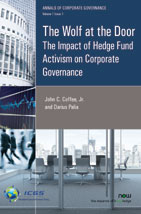The Wolf at the Door: The Impact of Hedge Fund Activism on Corporate Governance
By John C. Coffee, Jr., Columbia University, USA, jcc2@columbia.edu | Darius Palia, Rutgers University, USA, dpalia@rci.rutgers.edu
Abstract
Hedge fund activism has increased almost hyperbolically. Although some view this trend optimistically as a means for bridging the separation of ownership and control, we review the evidence and find it far more mixed. In particular, engagements by activist hedge funds appear to be producing a significant externality: severe cut-backs in long-term investment (and particularly a reduction in investment in research and development) by both the targeted firms and other firms not targeted but still deterred from making such investments. We begin by surveying the regulatory and institutional developments that have reduced the costs and increased the expected payoff from activism for activist investors. We give particular attention to new tactics (including the formation of “wolf packs”—loose associations of activist funds that do not constitute a “group” under the Williams Act) and new institutional structures (such as the alliance between an activist hedge fund and a strategic bidder struck in the recent Allergan takeover battle). Then, we survey the empirical evidence on how the investment horizons of firms are changing. Next, we review prior studies on the impact of activism, looking successively at (1) who are the targets of activism?; (2) does hedge fund activism create real value?; (3) what are the sources of gains from activism?; and (4) do the targets of activism experience post-intervention changes in real variables? We find the evidence decidedly mixed on most questions. Finally, we examine the policy levers that could encourage or curb hedge fund activism and consider the feasibility of reforms (including with respect to the law on insider trading). In particular, we consider possible private ordering responses, including new defensive tactics. Our policy preference is to find the least restrictive alternative.
The Wolf at the Door: The Impact of Hedge Fund Activism on Corporate Governance
The Wolf at the Door: The Impact of Hedge Fund Activism on Corporate Governance has three basic aims: (1) to understand and explain the factors that have caused the recent explosion in hedge fund activism; (2) to examine the impact of this activism, including whether it is shortening investment horizons and discouraging investment in research and development; and (3) to survey and evaluate possible legal interventions with an emphasis on the least restrictive alternative.
Although there have been other lengthy surveys, the landscape of activism is rapidly changing and this brings into doubt the relevance of empirical papers that study hedge fund activism in earlier decades. The authors suspect that the recent success of such activism may be fueling a current “hedge fund bubble” under which an increasing number of activist funds are pursuing a decreasing, or at least static, number of companies that have overinvested. This monograph is particularly focused on those markets and the legal forces that may be driving this bubble.
After an introduction, Section 2 begins with an analysis of those factors that have spurred greater activism on the part of hedge funds. Section 3 considers evidence suggesting that as the composition of a firm’s shareholder population shift towards more “transient” holders, its investment horizon shortens. Section 4 surveys recent studies to reach assessments about who the targets of hedge fund activism are; the stock price returns from hedge fund activism and the distribution of those returns; the degree to which wealth transfers explain the positive stock price returns to activism; the post-intervention evidence about changes in operating performance of hedge fund targets; and the holding periods and exit strategies of hedge fund activists. Section 5 evaluates some policy options looking for the least drastic means of accomplishing policy goals. Finally, Section 6 offers a brief conclusion that surveys how the changing structure of shareholder ownership and the recent appearance of temporary shareholder majorities complicate corporate governance, both empirically and normatively.
